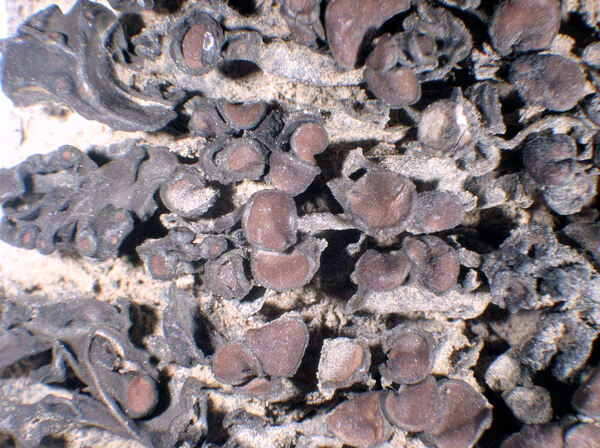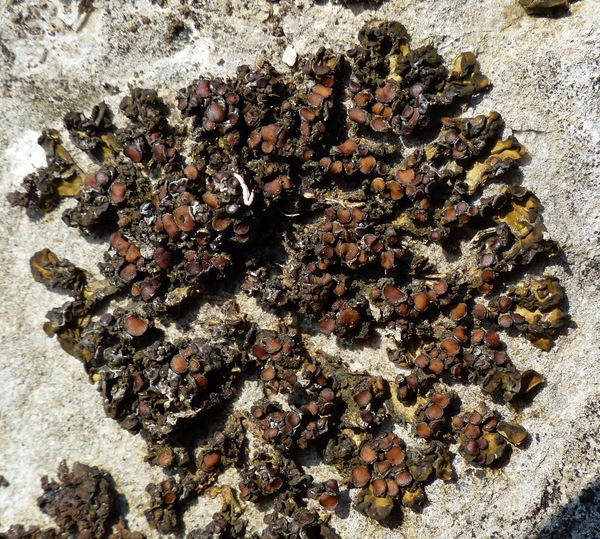Enchylium polycarpon (Hoffm.) Otálora, P.M. Jørg. & Wedin subsp. corcyrense (Arnold) Cl. Roux
Bull. Soc. linn. Provence, 74: 124, 2023.. Basionym: Lathagrium orbiculare var. corcyrense Arnold - Flora, 70: 152, 1887.
Synonyms: Collema polycarpon Hoffm. subsp. corcyrense (Arnold) Pišút; Collema polycarpon var. corcyrense (Arnold) Degel.; Collema ragusanum Zahlbr.; Collema salevense (Müll. Arg.) Zahlbr.; Collema stygium var. stygioides Flagey; Lathagrium akralense Flagey
Distribution: N - VG (TSB 6529), Lomb, Piem, Lig. C - Laz (Nimis & Tretiach 2004), Sar. S - Camp (Nimis & Tretiach 2004), Pugl, Cal (TSB 6948), Si (Nimis & al. 1994).
Description: Thallus foliose, homoiomerous, gelatinous and 200-300 µm thick when wet, deeply lobed, forming 3-8(-20) cm wide rosettes. Lobes radiating, elongate, 2-4(-6) mm wide, contiguous, adnate for most of their length, with small adventive, ascending or erect lobules along the margins towards the center, often slightly channelled towards apices, the tips much swollen and coarsely plicate. Upper surface olive-green to brownish, more rarely black, dull, sometimes with granular isidia-like outgrowths; lower surface usually somewhat paler with tufts of white hapters. Upper and lower cortex absent. Apothecia common, lecanorine, terminal and marginal, crowded towards thallus center, sessile to stipitate (often borne on the marginal lobules), 1.5-3.5 mm across, with a flat to slightly convex, red-brown to (rarely) black disc, and a rather thick, smooth, persistent thalline margin. Thalline exciple ecorticate; proper exciple rather thin, euthyplectenchymatous or subparaplectenchymatous, with elongated cells; hymenium colourless, 65-110 µm high, I+ blue; paraphyses simple or sparingly branched in upper part, 2-3 µm thick at mid-level, the apical cells 4-6.5 µm wide; hypothecium yellowish or yellowish brown, I+ blue. Asci 8-spored, cylindrical-clavate, the apex strongly thickened, the apical dome K/I+ pale blue, with a downwardly projecting K/I+ deep blue tubular structure. Ascospores (2-)3(-4)-septate, hyaline, fusiform with acute ends, 15-34 x 6.5-8.5 µm. Pycnidia laminal or marginal, immersed in warts, globose, paler than thallus. Conidia bacilliform, usually with swollen ends, straight or slightly curved, 5-7 x 1-1.5 µm. Photobiont cyanobacterial (Nostoc, the cells in long chains). Spot tests: all negative. Chemistry: without lichen substances.Note: more thermophytic and more southern than the typical subspecies, this taxon is worthy of further study.
Growth form: Foliose, broad lobed
Substrata: rocks
Photobiont: cyanobacteria, filamentous (e.g. Nostoc, Scytonema)
Reproductive strategy: mainly sexual
Commonnes-rarity: (info)
Alpine belt: absent
Subalpine belt: absent
Oromediterranean belt: absent
Montane belt: extremely rare
Submediterranean belt: rare
Padanian area: very rare
Humid submediterranean belt: rather rare
Humid mediterranean belt: rather rare
Dry mediterranean belt: rare

Predictive model
Herbarium samples
Growth form: Foliose, broad lobed
Substrata: rocks
Photobiont: cyanobacteria, filamentous (e.g. Nostoc, Scytonema)
Reproductive strategy: mainly sexual
Commonnes-rarity: (info)
Alpine belt: absent
Subalpine belt: absent
Oromediterranean belt: absent
Montane belt: extremely rare
Submediterranean belt: rare
Padanian area: very rare
Humid submediterranean belt: rather rare
Humid mediterranean belt: rather rare
Dry mediterranean belt: rare

Predictive model
| Herbarium samples |




